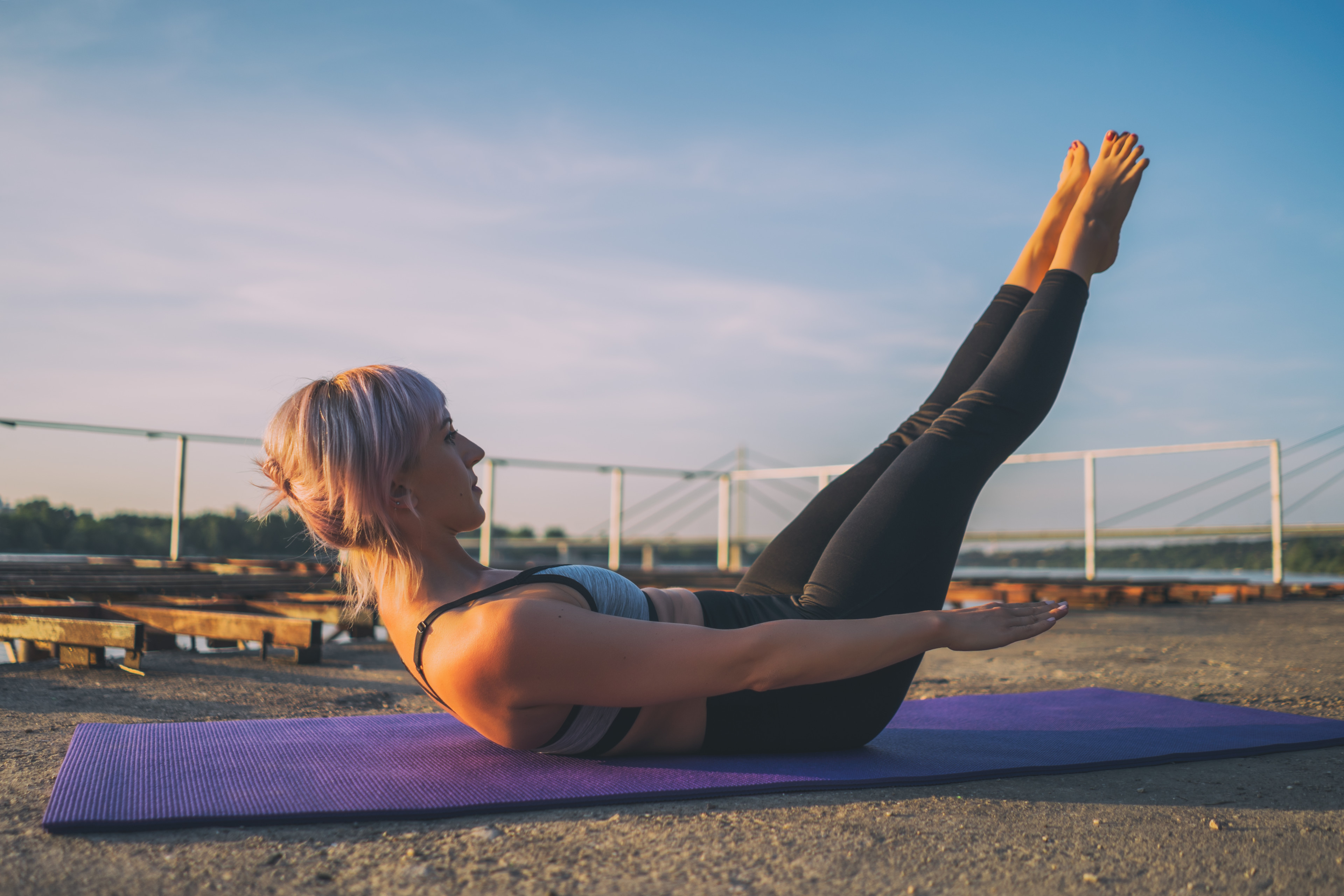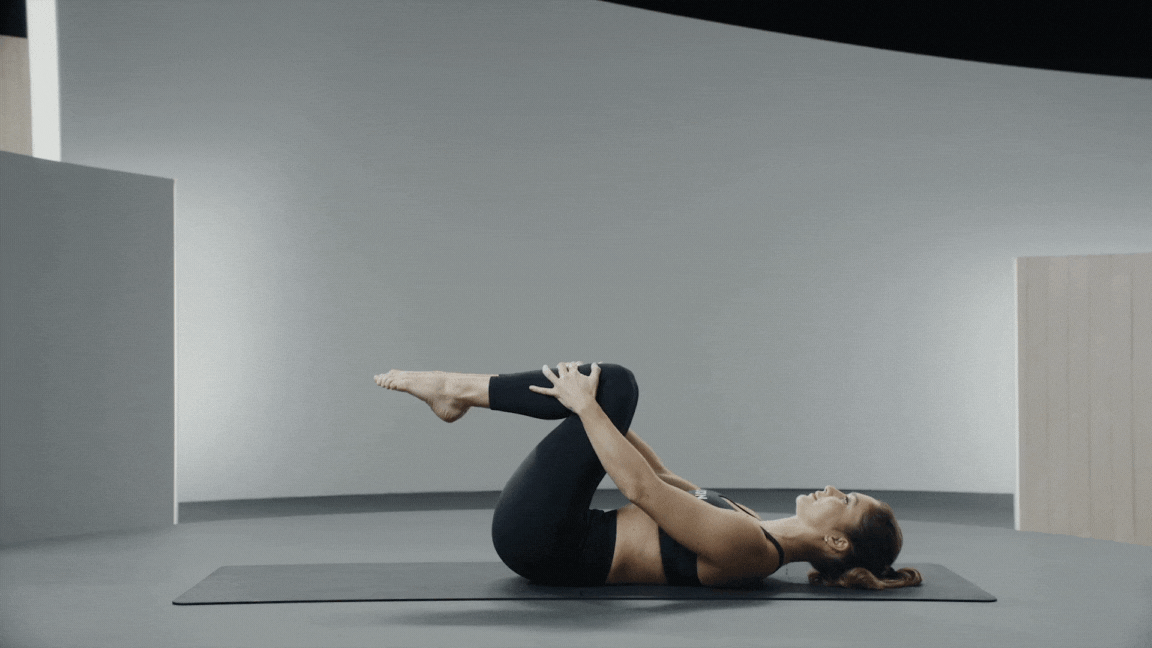
This Classic Pilates Move Works Every Muscle Group In 2 Minutes
It's way more than a warm-up exercise.
By Erin Bunch •
What Is the Pilates Hundred?
The Benefits of the Pilates Hundred
How to Do the Hundred In Pilates
Pilates Hundreds: Modifications and Variations
Common Mistakes to Avoid When Doing the Pilates Hundred
How To Add the Hundred to Your Pilates Routine
If you’ve ever taken a Pilates class, odds are good that it began with the Pilates Hundred exercise. This classic move is a mainstay for good reason; it requires no equipment, takes just two minutes, and works not only the core (for which it’s most notably deployed) but also the arms and legs. In other words, the hundreds exercise offers a lot of bang for your buck, and it’s an exercise that works for every level of experience, including beginners.
Discover more ways to reach your goals with Peloton
Below, we dive into the history of the Pilates Hundred, its many benefits, how to execute it with proper form, popular modifications, and the best ways to incorporate it into your workout routine.
What Is the Pilates Hundred?
The Pilates Hundred is one of the 34 original Pilates moves described by Joseph Pilates in his 1945 book A Return to Life Through Contrology. It’s an exercise that involves pumping your arms five times on an inhalation and five times on an exhalation while holding yourself up by your abs, with your legs extended and arms alongside your hips, palms down.
“It is used as a warm up to get the blood flowing and the entire body ready for the full workout,” says Kristen McGee, Peloton Instructor. “It also establishes a good breathing pattern and helps us connect with our breath.” And while the name “Hundred” makes the move sound a bit daunting, rest assured that it does not refer to a number of reps but rather the total number of times your arms pump up and down as you complete the exercise.
The Benefits of the Pilates Hundred
The Pilates 100’s staying power in the ever-evolving fitness world is a testament to its tried-and true benefits, which include the following:
Strengthens Abs
The hundreds exercise is best-known for its ability to effectively work the core. “It connects us with our powerhouse and gets the abs working right away,” says Kristen. This exercise targets the entire abdominal wall, strengthening the transverse abdominals and the obliques. It also helps with core stability, or the ability of the muscles in the torso to maintain proper alignment of the spine and pelvis during movement. This in turn helps enhance balance, support the spine, improve the efficiency of everyday activity, and reduce injury.
Works the Entire Body
As noted above, the Pilates Hundred doesn’t just target the core. The arm-pumping motion gets your arms and shoulders involved, too. Your inner thighs, glutes, and hip flexors will also be activated.
Gets The Blood Pumping
The hundreds exercise quickly increases your heart rate and improves circulation. “The Hundred is great for warming up the body for the more intense mat or equipment work to follow,” says Kristen.
Improves Breathing
The specific breath pattern which accompanies the Pilates 100 increases oxygen intake, regulates the breath, and can help increase lung capacity and respiratory function over time.
How to Do the Hundred In Pilates
The Pilates Hundred offers clear benefits, but proper form is critical. Without it, neck and shoulder strain is common. It’s advisable to perform the Hundred on a mat or appropriate Pilates machine. Here, McGee describes how to perform the move in detail.

Step-By-Step Instructions For the Pilates 100
Lie down on your back, making sure that your lower back is firmly rooted into the ground.
Bring your legs to the tabletop position.
Lift your head, neck, and shoulders up a few inches from the floor, keeping your chin tucked down, your lower back on the ground, and your abs scooped.
Extend your arms alongside your waist with the palms facing down and fingertips reaching for the wall in front of you.
Extend your legs to a 45-degree angle, or to where the wall and ceiling meet. If your lower spine pulls off the mat, lift your legs until they’re reached a position where your spine is grounded again.
Begin vigorously pumping the arms up and down five times on an inhale and five times on an exhale. Inhale through your nose, exhale through your mouth. Try to keep your neck and shoulders relaxed so they’re not doing the work meant for your abs.
Repeat for 10 rounds, or a total of 100 pumps.
Pilates Hundreds: Modifications and Variations
The Pilates 100 is safe for all levels, but as with any exercise, it’s important to listen to your body and adopt modifications when necessary. Fortunately, this is an easy move to alter if you’re new to the exercise, want to make it more challenging, or have back or neck issues. Expectant mamas should note, however, that this move is to be avoided altogether after the first trimester of pregnancy, or whenever a bump is present. It’s also advisable to skip the Pilates Hundred if you have issues with your pelvic floor.
Beginner Modifications
If you are new to the Pilates 100, or feel your lower back lifting from the floor as you execute the move, you can lift your legs above 45 degrees, up to 90 degrees (a.k.a. straight up to the ceiling). “You can also keep your legs in tabletop, or even flat on the floor to begin with,” says Kristen. Newbies can also opt for keeping both their head and their feet flat on the floor initially, and then slowly lifting one leg at a time to tabletop as they get more comfortable with the exercise.
Advanced Modifications
To add difficulty to the move, you can keep a Pilates ring or ball squeezed between your legs as you execute the Hundred. This will increase activation in the core.
Modifications to Accommodate Injury
If you have neck issues, Kristen recommends using a block under your head, or placing one hand behind the head and pumping with the other, then alternating to the other side. You can also keep your head down on the mat to reduce strain on the neck and back, or keep your feet down on the floor, with knees bent, and only lift your upper body. To eliminate any strain, you can even opt to keep both your head and feet down on the mat, with your knees bent.
Common Mistakes to Avoid When Doing the Pilates Hundred
Mistakes in form during the Pilates 100 can reduce the exercise’s efficacy and increase the risk or strain or injury. Here, some common errors to avoid:
1. Lifting from the neck: Lifting from the neck rather than the core can place strain on the neck and make the exercise less effective. To avoid this, make sure to lift both your shoulders and your neck off the ground. If you’re straining to keep your head up, Kristin recommends placing a ball or block under the neck. You can also lay your head flat, although this won’t work the core as intensely.
2. Not tucking your chin: Pointing your chin up at the ceiling also places strain on your neck. Instead, keep your chin tucked slightly down, leaving room about the size of a fist between your chin and chest.
3. Arching your back and/or tucking your hips: Kristen says it’s important to keep your pelvis neutral to avoid making these mistakes.
4. Breaking at the wrists: “Don’t let your hands point up or the wrists bend,” says Kristen. “You want to keep your arms and hands long.” Ultimately, the movement should be coming from your shoulders, not your wrists.
5. Legs too high or too low: If your legs are too high, your back will arch and your core will be less engaged. If they’re too low, you might strain your back. Keeping them at a 45-degree angle is advised unless you are specifically aiming to modify.
6. Forgetting to breathe: The designated breathwork which accompanies the Pilates 100 is a critical component of the move.
How To Add the Hundred to Your Pilates Routine
The Pilates 100 is a great addition to any Pilates workout. Kristen says it’s best to incorporate the Hundred at the beginning of your workout to warm up the body, but it can also be used as a standalone exercise in any workout regimen, or if you’re trying to work your core on-the-go. If you’ve never performed the Pilates 100 before, it’s best to watch a pro demonstrate first to ensure proper form.

Peloton App
Access thousands of classes with no equipment needed.
This content is for informational and educational purposes only and does not constitute individualized advice. It is not intended to replace professional medical evaluation, diagnosis, or treatment. Seek the advice of your physician for questions you may have regarding your health or a medical condition. If you are having a medical emergency, call your physician or 911 immediately.
Level up your inbox.
Subscribe for a weekly dose of fitness, plus the latest promos, launches, and events.
By providing your email address, you agree to receive marketing communications from Peloton.
For more about how we use your information, see our Privacy Policy.








